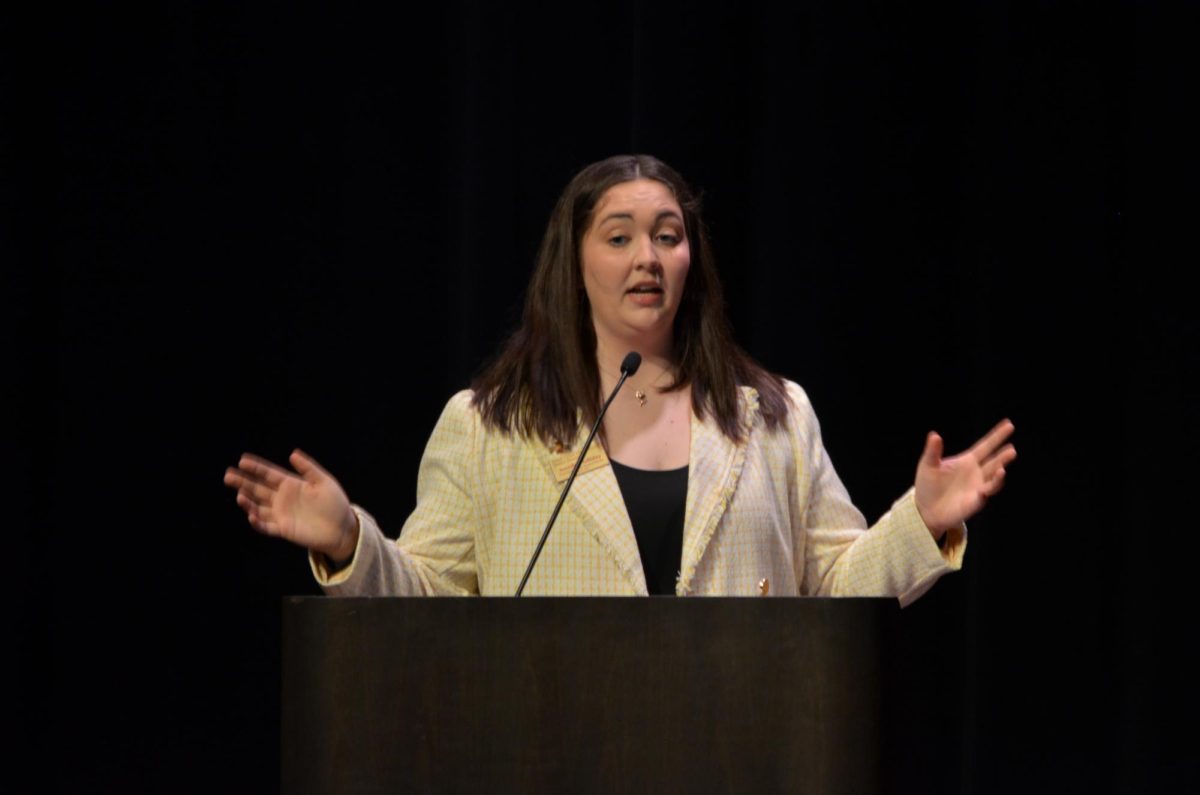It’s hard to get around
November 28, 2007
It’s only 12:30 in the afternoon, and my arms are already aching. My hands have begun to show signs of blistering, and I’ve worked up quite a sweat from the constant physical exertion. Not only has my normal 20-minute walk turned into a grueling two-hour trek, but potholes, cracks in the sidewalk and godforsaken hills have impeded my travel.
Unfortunately, many people don’t realize that what sounds like a triathlon workout is really just the daily struggle of using a wheelchair.
With a small population of people on campus who require the use of wheelchairs, many times their needs have gone unnoticed, leaving the problems unsolved.
“It’s quite frustrating,” said Nancy Evans, professor of educational leadership and policy studies. “The campus administration is not responsive and takes forever to get around to fixing things.”
As a polio survivor, Evans spent most of her life using a cane, but she began using a wheelchair four years ago to make movement easier. Evans noted that the only elevator leading to her office on the second floor of Lagomarcino was broken for six weeks before being repaired. During that time, she had no access to her office, the staff, or the graduate students who worked with her.
“It seemed like they were nursing the elevator along, since it had been having problems on and off for a while, but there wasn’t enough money in the repair budget to do anything about it,” she said.
Given that Evans is a professor, one might assume that part of her job is to teach students. However, when the Dean’s Office assigned her to teach a class in Lagomarcino, the doors were too heavy for her to open, and she was unable to get into the classroom. After requesting automatic door openers for over a year, she was forced to declare that she would not teach the class unless it was moved to a more accessible location.
Even though the Americans with Disabilities Act was established in 1990, the ISU campus has seen slow progress in regard to accessibility for the mobility-impaired over the past 17 years.
Since the Disabled Student Accommodation Fund is given .05 percent of Iowa State’s $1.07 billion annual income, or about $5 million, the Disabilities Resource Office is hard pressed to solve all the problems students and faculty encounter.
Steven Moats, director of Student Disability Resources, said his office had a “big load of work” left to do and that hiring more staff would be the best way to help Iowa State meet ADA regulations.
As I continued wheeling myself around campus throughout the day, I quickly decided that this was as close to experiencing hell as I ever wanted to get. I imagine sinners in the ninth circle must be going through a similar punishment, pushing their wheelchairs up a pothole-riddled hill for all eternity – only to have it roll back down, doomed to start over again. Sisyphus had it easy.
Although I only had to deal with my wheelchair reliance for a short time, I was surprised at how it affected my attitude and emotional state. I began feeling moody and a bit depressed as the day went on. Simple things, such as attending class, took their toll as I began dreading the inevitable fiasco of maneuvering around a room full of desks trying to find an open spot to sit. It’s amazing how much we take for granted before we are forced to drive around in a square device that was supposed to make mobility easier.
Vivian d’Alelio, junior in English, was born with cerebral palsy and now finds using a wheelchair to be the easiest way to travel. Along with the physical mobility impairment, her eyesight has been affected by the disease, which makes it difficult to understand what is happening from long distances. She wholeheartedly agreed with my complaints about the size and accessibility of the classrooms.
“The classrooms are really cramped,” she said. “The doors are tiny and hard to get through. I have to try and fit with a wheelchair around all the other students and desks, and I usually have to come late just so I don’t block the door. I guess, in the end, you just have to deal with what they’ve got, but I suppose that’s not very good justification, is it?”
In classrooms like the basement auditorium in Carver Hall, Vivian found it impossible to reach the front of the room in order to see and hear the instructor better. She asked if there was an elevator to the bottom of the building, so she could enter from the bottom doors, but was told there was no way to get to the front of the room in a wheelchair. She was forced to sit at the top of the auditorium, making it much harder to observe the lecture and course activities.
Probably the most-complained-about feature of the Iowa State campus is the toilet stalls. No other aspect of the university garners so much criticism from people in wheelchairs. The restrooms are not only lacking in number of accessible stalls, but in size as well. Something as simple as using a toilet quickly became yet another chore I had to deal with.
After I directed myself into the stall in Hamilton Hall, I was forced to exit my chair backwards, across from the toilet because of the lack of space to turn around. To further add to my frustration, I had to reach across the obviously dirty seat to grasp a rail in order to pull myself up. Once I had completed the equivalent of a gymnast’s parallel bar exercise, I was proud of myself. Then the realization that the struggle was far from over set in. My old nemesis gravity was back with a vengeance, as I still had to get back into my wheelchair. The struggle that ensued was long and arduous but, eventually, I was able to get back into the chair, unlock the stall door, and wheel myself to the sink.
While washing my hands was easy enough, my attempt to dry them was a bit more frustrating. The towel dispenser had been attached to the wall at a height that make it accessible to someone standing. I suppose I should be thankful to have made it out of the restroom in just 20 minutes.
Although I was lucky enough to have a facility in the building where I was working, there are places on campus that do not have accessible restrooms. D’Alelio, who spends most of her time in Ross Hall, was not able to use any of the facilities in the building.
“I have to go all the way to Catt Hall to go to the bathroom,” she said. “It’s hard because a handicap bathroom is scarce to find. There needs to be some way to know if a building is going to be handicap-accessible.”
Evans is fortunate enough to have two accessible restrooms in Lagomarcino, but due to the size of the building and its expansive layout, she still has to travel a significant distance to reach the restroom.
“What the university seems to consider as accessible stalls is very questionable. Privacy issues are very important, and there are many cases of stall doors opening inwards so they can’t be closed unless the wheelchair is left outside the stall. I’ve really had to negotiate with the layouts and often go out of the way just to find a restroom,” Evans said. “The university needs to understand that we can’t do things spontaneously. There [aren’t any signs] on campus to show where accessible spots are and I have to plan to do anything, even just to find a restroom.”
With winter coming, a new challenge will soon rear its ugly head for those on four wheels: snow and ice. In one such instance of the aforementioned apathy, Evans was forced to traverse a slick parking lot to get to her office because she didn’t have seniority. To add insult to injury, the professor who had the closest spot to Lagomarcino was retired and didn’t have to show up on a daily basis.
“It’s literally impossible to get through a snowy parking lot or up an icy wheelchair ramp,” Evans said. “I just don’t have the arm strength to get up ramps and hills, especially in the winter. Luckily for me, I have a partner who is able to help me get around, since he works on campus anyway. There are people who don’t have that resource that I do, and they have it even rougher than I do.”
The snow removal services on the Iowa State campus are infamous for their half-assed job of clearing sidewalks and parking lots, which causes considerable aggravation for people trying to get around. The Disabilities Resource Office does its best to clear the routes that students take to class but often does little good. When the plows clear the roads, they often pile the excess snow on the curb cuts, which are supposed to make it possible for wheelchairs to get across roads. In d’Alelio’s case, the piled snow led to a concussion; unable to get through mounds of packed snow, she tried desperately to ram her wheelchair through, causing her chair to flip backwards and spill her into the road, leaving her with a nasty injury.
“There was nothing I could do to get through the snow. As a last measure, I tried to force my way through and ended up in the road. The whole time I laid there, I just prayed someone would actually stop to help me. It took a while, but finally a few people stopped what they were doing and helped me out.”
As I sat at the bus stop shivering from the cold air that had begun to whip around the corner, I felt relief that I would soon be on a warm bus and able to take a break from wheeling myself around. Of course, I assumed that all the CyRide buses would be accessible. Isn’t it logical that one of the first upgrades would be to the buses? Unfortunately, there are still 15 buses in the 51-bus fleet that are not accessible to wheelchairs. Ironically, some of these buses are on the orange route – the route that is supposed to drop students with physical and learning disabilities off at the Hixson-Lied Student Success Center where they take tests.
“One problem with CyRide is that a lot of the orange buses aren’t handicap accessible. And these are mainly the buses that go to Hixson-Lied, where I take tests,” d’Alelio said. “And, not only do I have to wait for 30 minutes in the dead of winter for a bus that I can get on, but there are still curbs that haven’t been cut for wheelchairs, so we can’t enter and exit buses at the stops.”
With so many issues on campus, one might expect a public outcry for equal treatment, but many of these issues go unnoticed because they don’t affect the majority of people, who are able to walk.
“I don’t expect them to change everything for me. I’m trying to be patient about the things that still need fixing and, hopefully, they’ll be addressed eventually,” Vivian said.
Maybe that’s the problem. Nothing will change as long as people aren’t held accountable for their failure to pay attention. If apathy and ignorance continue to prevail, advancements and simple fixes in accessibility will continue to be put on hold. Maybe what we really need to do is stop giving the administration so much leeway and force them to start acting.
















